stop start TOYOTA HIGHLANDER 2016 XU50 / 3.G Quick Reference Guide
[x] Cancel search | Manufacturer: TOYOTA, Model Year: 2016, Model line: HIGHLANDER, Model: TOYOTA HIGHLANDER 2016 XU50 / 3.GPages: 52, PDF Size: 2.28 MB
Page 5 of 52

OVERVIEW
FEATURES/OPERATIONS
SAFETY AND EMERGENCY FEATURES
3
Automatic air conditioning
Type A
Type B
Lower center console switches
Seat heater/ventilator switches1
Power Liftgate (back door) main switch (inside glove box)1
“ENGINE START STOP” button (Smart Key)1
Ignition (standard key)1
Tilt and telescopic steering lock release
Fuel tank door opener
Hood lock release lever
Automatic High Beam (AHB) switch
1
Blind Spot Monitor (BSM) switch1
Lane Departure Alert (LDA) switch1
Power Liftgate (back door) switch
Intuitive parking assist switch (rear parking sonar)1
Heated steering wheel switch1
Windshield wiper de-icer switch1
1
If equipped 2 Refer to the “Navigation System Owner’s Manual.”3
Refer to the “2016 Entune™ Audio Quick Reference Guide.”
Page 9 of 52
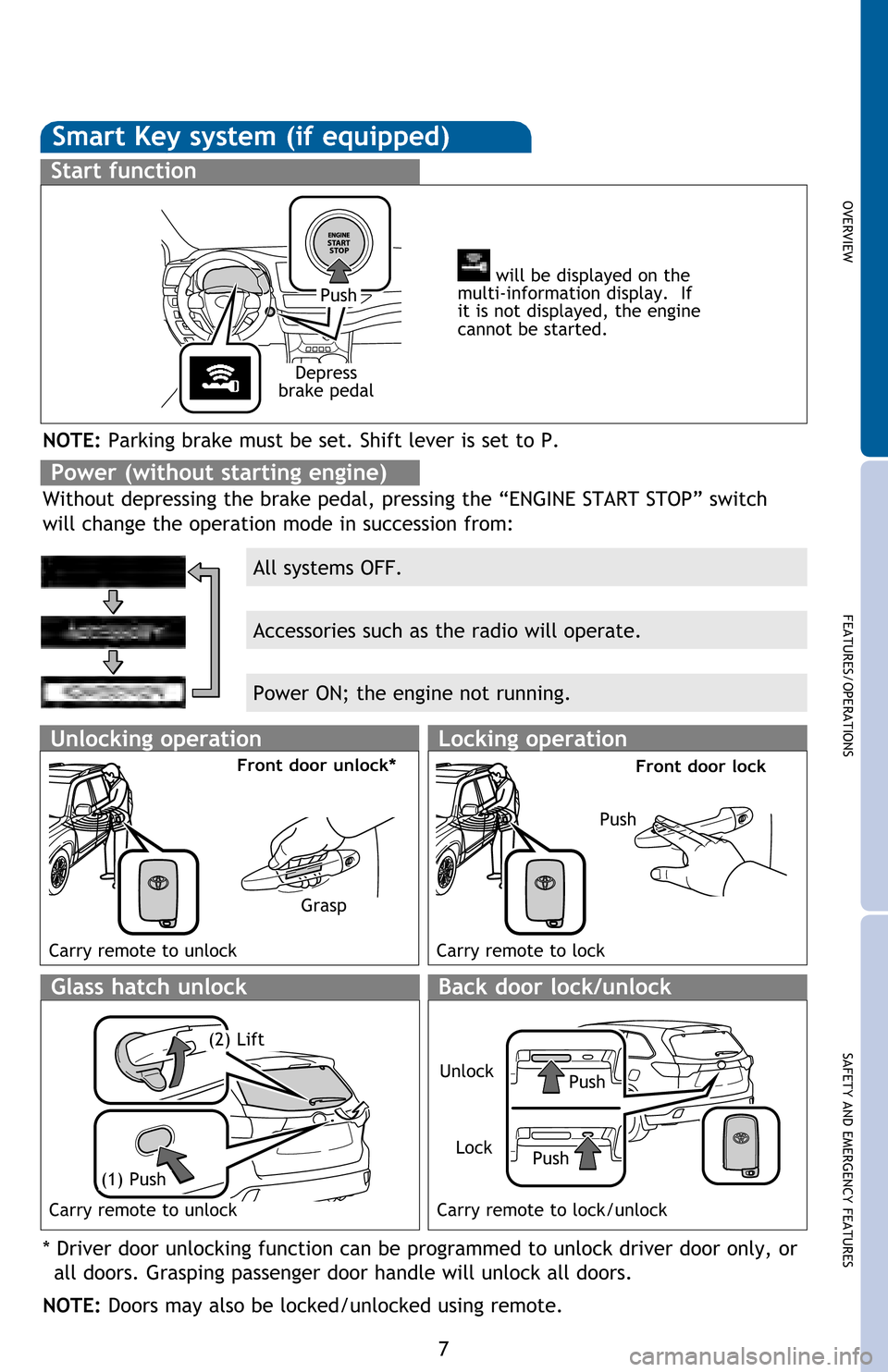
OVERVIEW
FEATURES/OPERATIONS
SAFETY AND EMERGENCY FEATURES
7
Smart Key system (if equipped)
Start function
All systems OFF.
Accessories such as the radio will operate.
Power ON; the engine not running. NOTE: Parking brake must be set. Shift lever is set to P.
Push
Depress
brake pedal
will be displayed on the
multi-information display. If
it is not displayed, the engine
cannot be started.
Without depressing the brake pedal, pressing the “ENGINE START STOP” switch
will change the operation mode in succession from:
Power (without starting engine)
* Driver door unlocking function can be programmed to unlock driver door only, or
all doors. Grasping passenger door handle will unlock all doors.
NOTE: Doors may also be locked/unlocked using remote.
Glass hatch unlock
Locking operation
Carry remote to lock
Front door lock
Push
(1) Push
Back door lock/unlock
Push
Lock
Push Unlock
Carry remote to unlock Carry remote to lock/unlock
Unlocking operation
Carry remote to unlock
Front door unlock*
Grasp
(2) Lift
Page 12 of 52
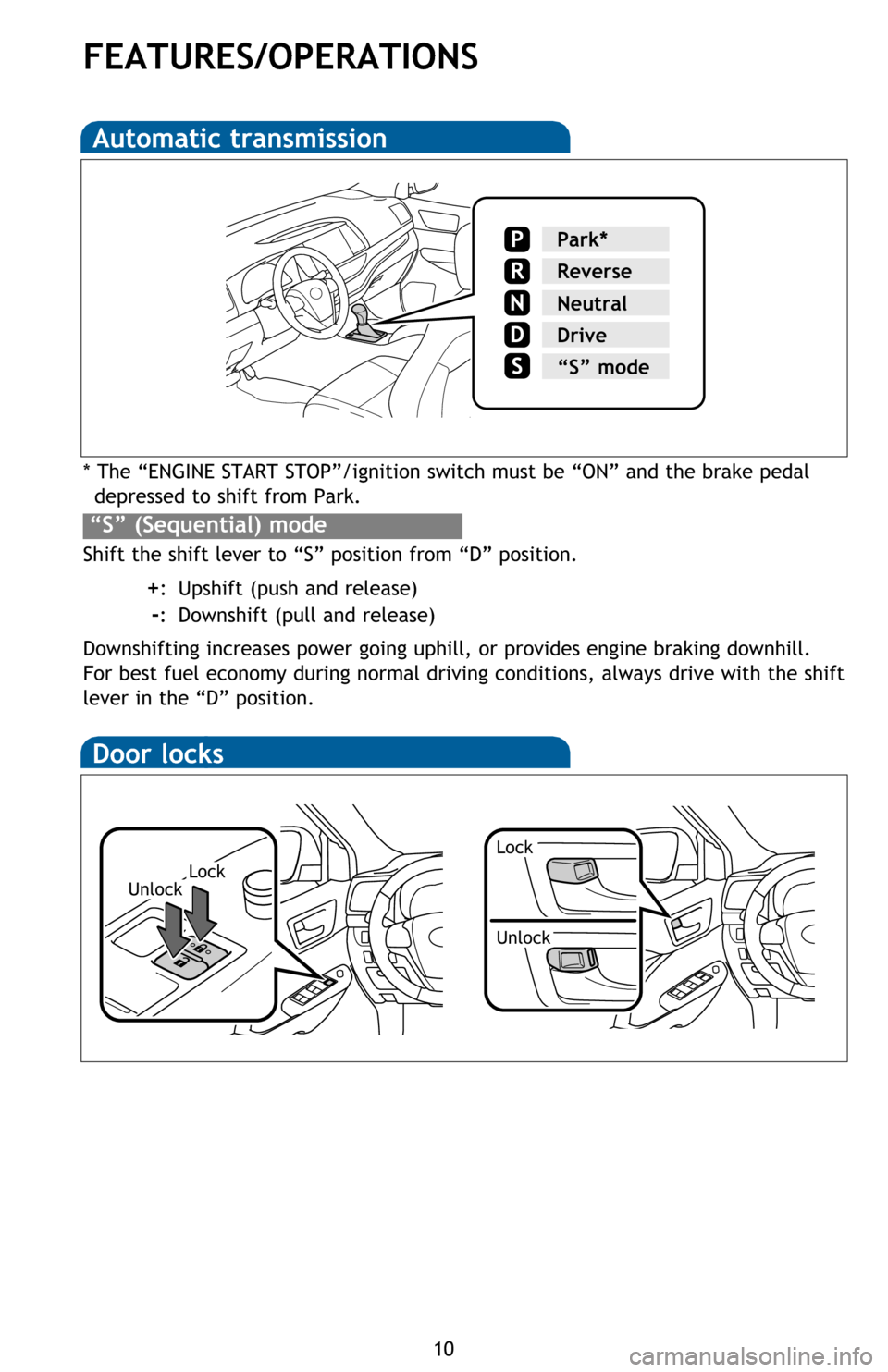
10
FEATURES/OPERATIONS
Automatic transmission
* The “ENGINE START STOP”/ignition switch must be “ON” and the brake pedal
depressed to shift from Park.
Shift the shift lever to “S” position from “D” position.
+: Upshift (push and release)
-: Downshift (pull and release)
Downshifting increases power going uphill, or provides engine braking downhill.
For best fuel economy during normal driving conditions, always drive with the shift
lever in the “D” position.
“S” (Sequential) mode
Park*
Reverse
Neutral
Drive
“S” mode
Door locks
LockUnlock
Unlock
Lock
Page 13 of 52
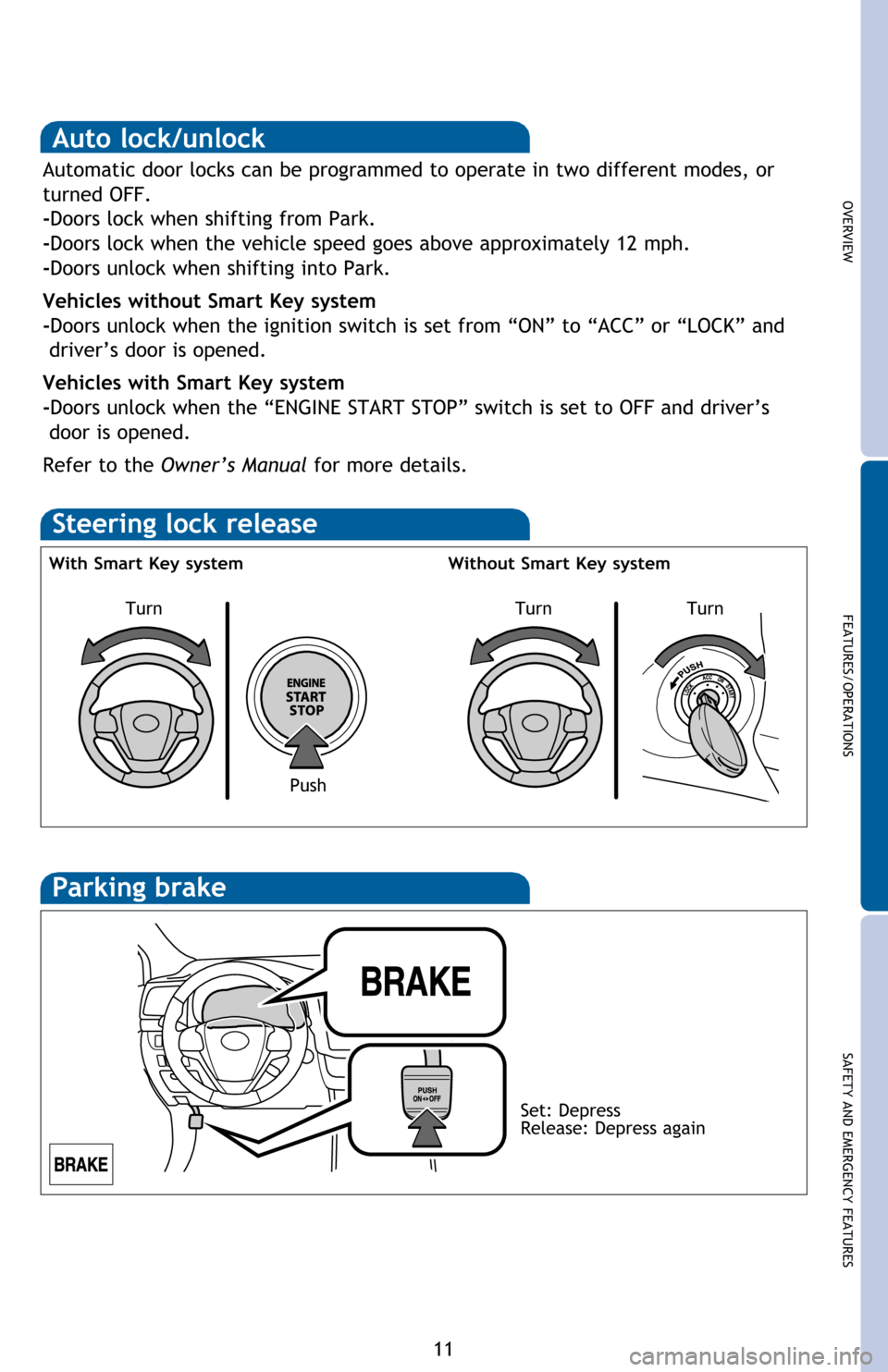
OVERVIEW
FEATURES/OPERATIONS
SAFETY AND EMERGENCY FEATURES
11
Steering lock release
With Smart Key system Without Smart Key system
PushTurn Turn
Turn
Auto lock/unlock
Automatic door locks can be programmed to operate in two different modes, or
turned OFF.
-Doors lock when shifting from Park.
-Doors lock when the vehicle speed goes above approximately 12 mph.
-Doors unlock when shifting into Park.
Vehicles without Smart Key system
-Doors unlock when the ignition switch is set from “ON” to “ACC” or “LOCK” and
driver’s door is opened.
Vehicles with Smart Key system
-Doors unlock when the “ENGINE START STOP” switch is set to OFF and driver’s
door is opened.
Refer to the Owner’s Manual for more details.
Parking brake
Set: Depress
Release: Depress again
Page 18 of 52
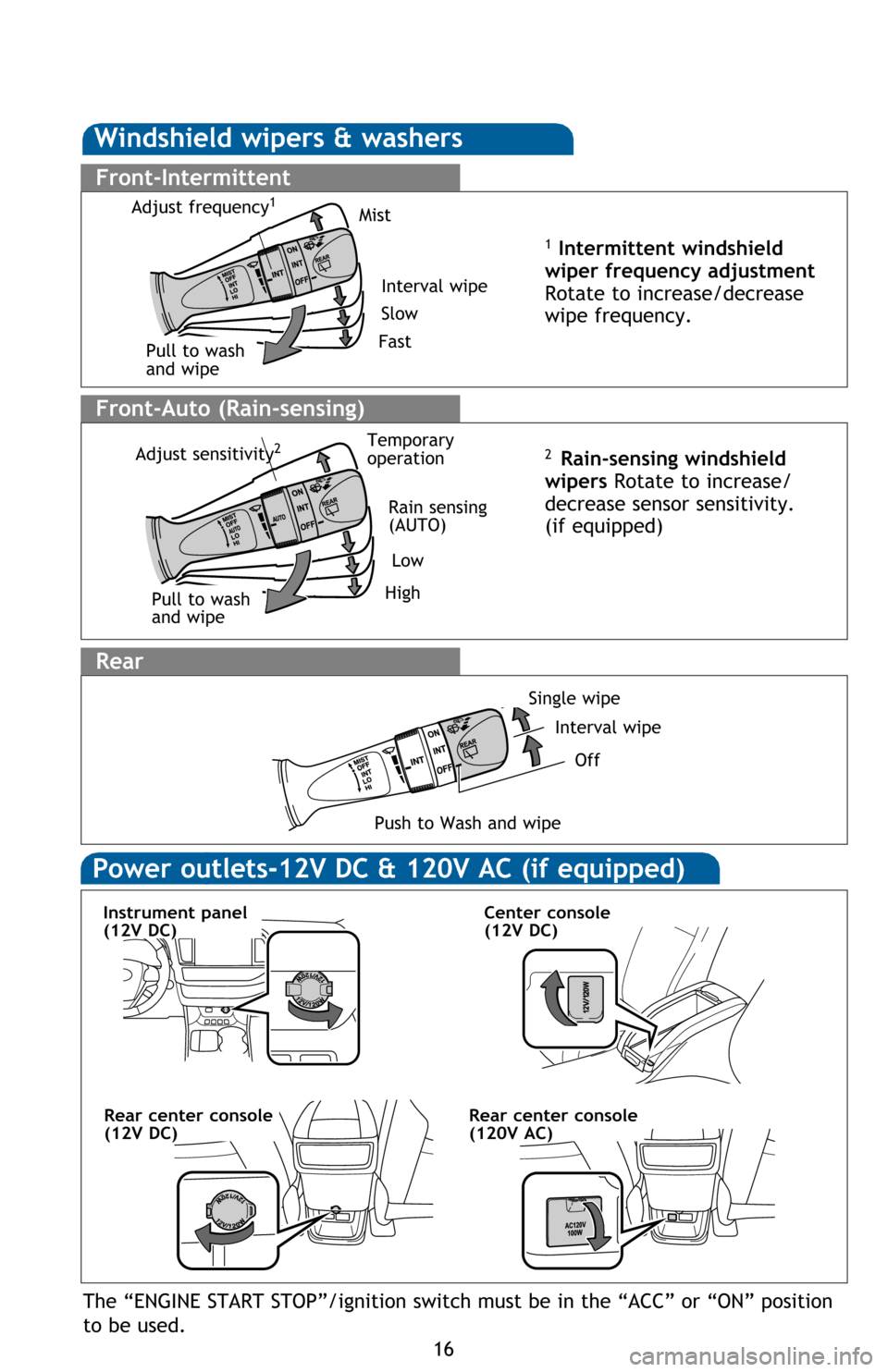
Windshield wipers & washers
16
Power outlets-12V DC & 120V AC (if equipped)
Instrument panel
(12V DC)
The “ENGINE START STOP”/ignition switch must be in the “ACC” or “ON” position
to be used.
Center console
(12V DC)
Single wipe
Interval wipe
Off
Push to Wash and wipe
Rear
Front-Intermittent
Front-Auto (Rain-sensing)
1 Intermittent windshield
wiper frequency adjustment
Rotate to increase/decrease
wipe frequency.
2 Rain-sensing windshield
wipers Rotate to increase/
decrease sensor sensitivity.
(if equipped)Temporary
operation
Rain sensing
(AUTO)
Low
HighAdjust sensitivity2
Pull to wash
and wipe
Interval wipe Mist
Slow
Fast Adjust frequency
1
Pull to wash
and wipe
Rear center console
(120V AC)Rear center console
(12V DC)
Page 28 of 52
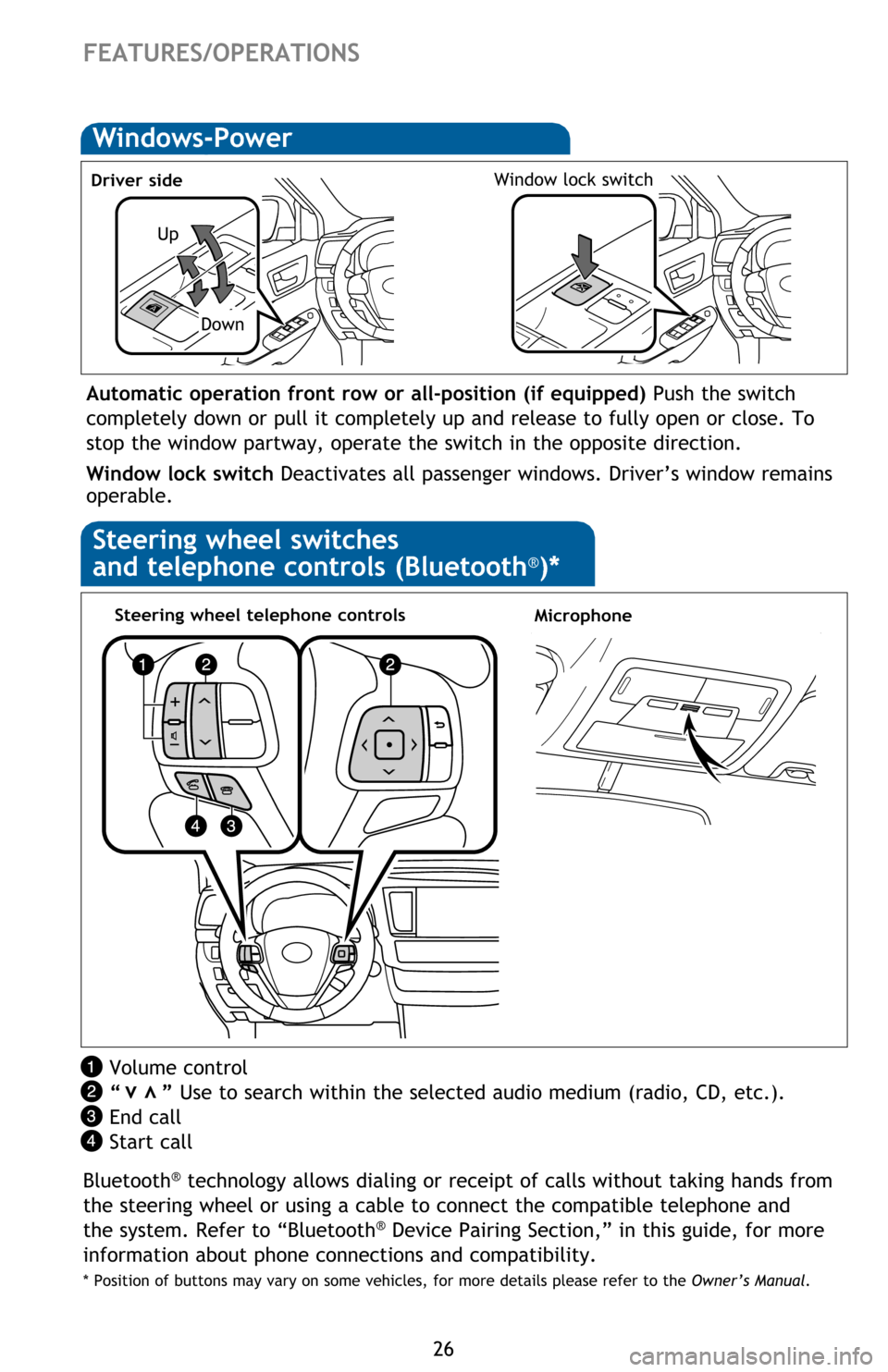
26
FEATURES/OPERATIONS
Windows-Power
Up
Down
Driver sideWindow lock switch
Automatic operation front row or all-position (if equipped) Push the switch
completely down or pull it completely up and release to fully open or close. To
stop the window partway, operate the switch in the opposite direction.
Window lock switch Deactivates all passenger windows. Driver’s window remains
operable.
MicrophoneSteering wheel telephone controls
Volume control
“ ” Use to search within the selected audio medium (radio, CD, etc.).
End call
Start call
vv
Steering wheel switches
and telephone controls (Bluetooth®)*
Bluetooth® technology allows dialing or receipt of calls without taking hands from
the steering wheel or using a cable to connect the compatible telephone and
the system. Refer to “Bluetooth
® Device Pairing Section,” in this guide, for more
information about phone connections and compatibility.
* Position of buttons may vary on some vehicles, for more details please refer to the Owner’s Manual.
Page 38 of 52
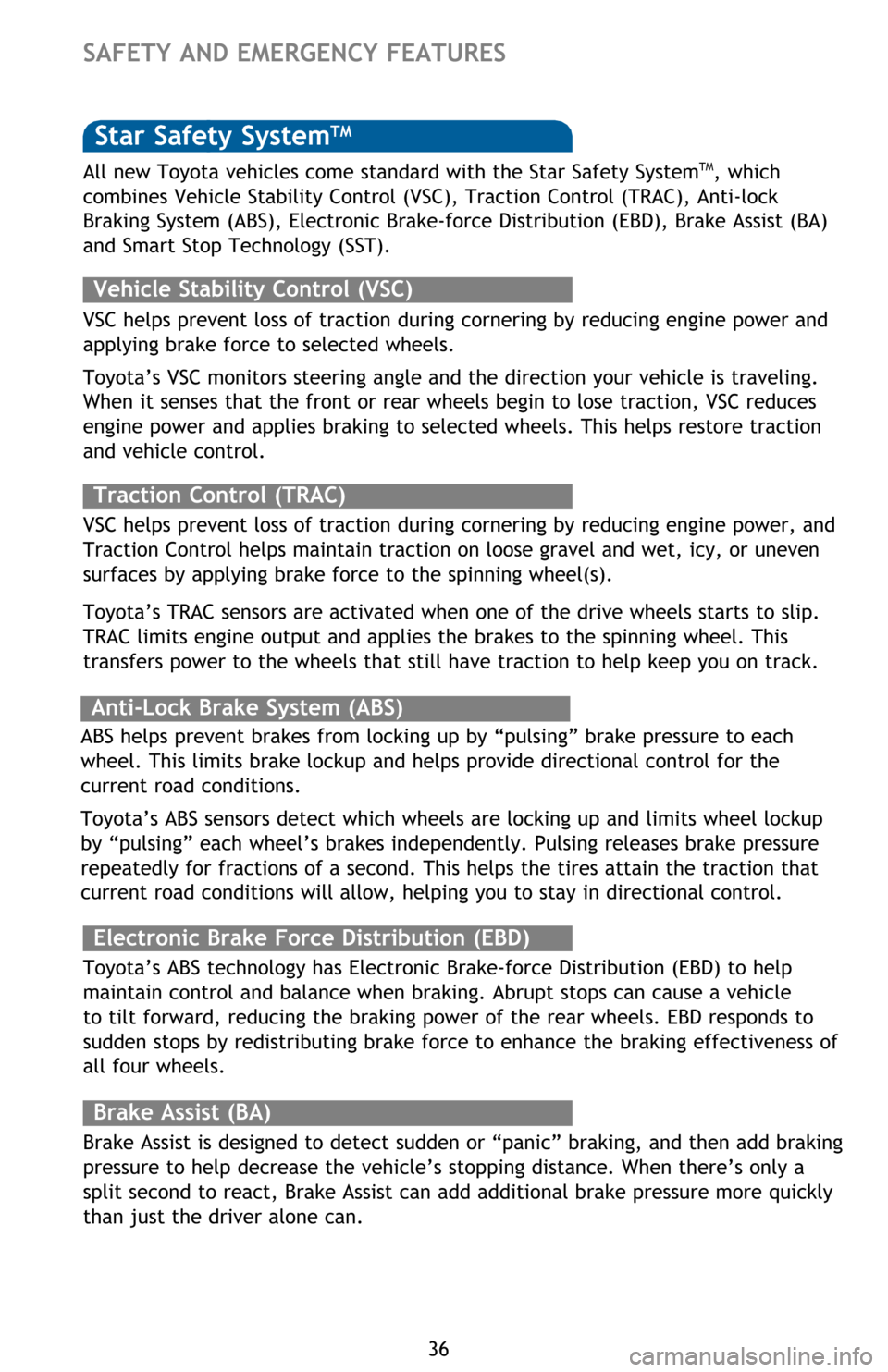
36
Star Safety SystemTM
VSC helps prevent loss of traction during cornering by reducing engine power and
applying brake force to selected wheels.
Toyota’s VSC monitors steering angle and the direction your vehicle is traveling.
When it senses that the front or rear wheels begin to lose traction, VSC reduces
engine power and applies braking to selected wheels. This helps restore traction
and vehicle control.
Vehicle Stability Control (VSC)
Anti-Lock Brake System (ABS)
Brake Assist (BA)
ABS helps prevent brakes from locking up by “pulsing” brake pressure to each
wheel. This limits brake lockup and helps provide directional control for the
current road conditions.
Toyota’s ABS sensors detect which wheels are locking up and limits wheel lockup
by “pulsing” each wheel’s brakes independently. Pulsing releases brake pressure
repeatedly for fractions of a second. This helps the tires attain the traction that
current road conditions will allow, helping you to stay in directional control.
Brake Assist is designed to detect sudden or “panic” braking, and then add braking
pressure to help decrease the vehicle’s stopping distance. When there’s only a
split second to react, Brake Assist can add additional brake pressure more quickly
than just the driver alone can. VSC helps prevent loss of traction during cornering by reducing engine power, and
Traction Control helps maintain traction on loose gravel and wet, icy, or uneven
surfaces by applying brake force to the spinning wheel(s).
Toyota’s TRAC sensors are activated when one of the drive wheels starts to slip.
TRAC limits engine output and applies the brakes to the spinning wheel. This
transfers power to the wheels that still have traction to help keep you on track.
Traction Control (TRAC)
Electronic Brake Force Distribution (EBD)
Toyota’s ABS technology has Electronic Brake-force Distribution (EBD) to help
maintain control and balance when braking. Abrupt stops can cause a vehicle
to tilt forward, reducing the braking power of the rear wheels. EBD responds to
sudden stops by redistributing brake force to enhance the braking effectiveness of
all four wheels. All new Toyota vehicles come standard with the Star Safety System
TM, which
combines Vehicle Stability Control (VSC), Traction Control (TRAC), Anti-lock
Braking System (ABS), Electronic Brake-force Distribution (EBD), Brake Assist (BA)
and Smart Stop Technology (SST).
SAFETY AND EMERGENCY FEATURES
Page 39 of 52
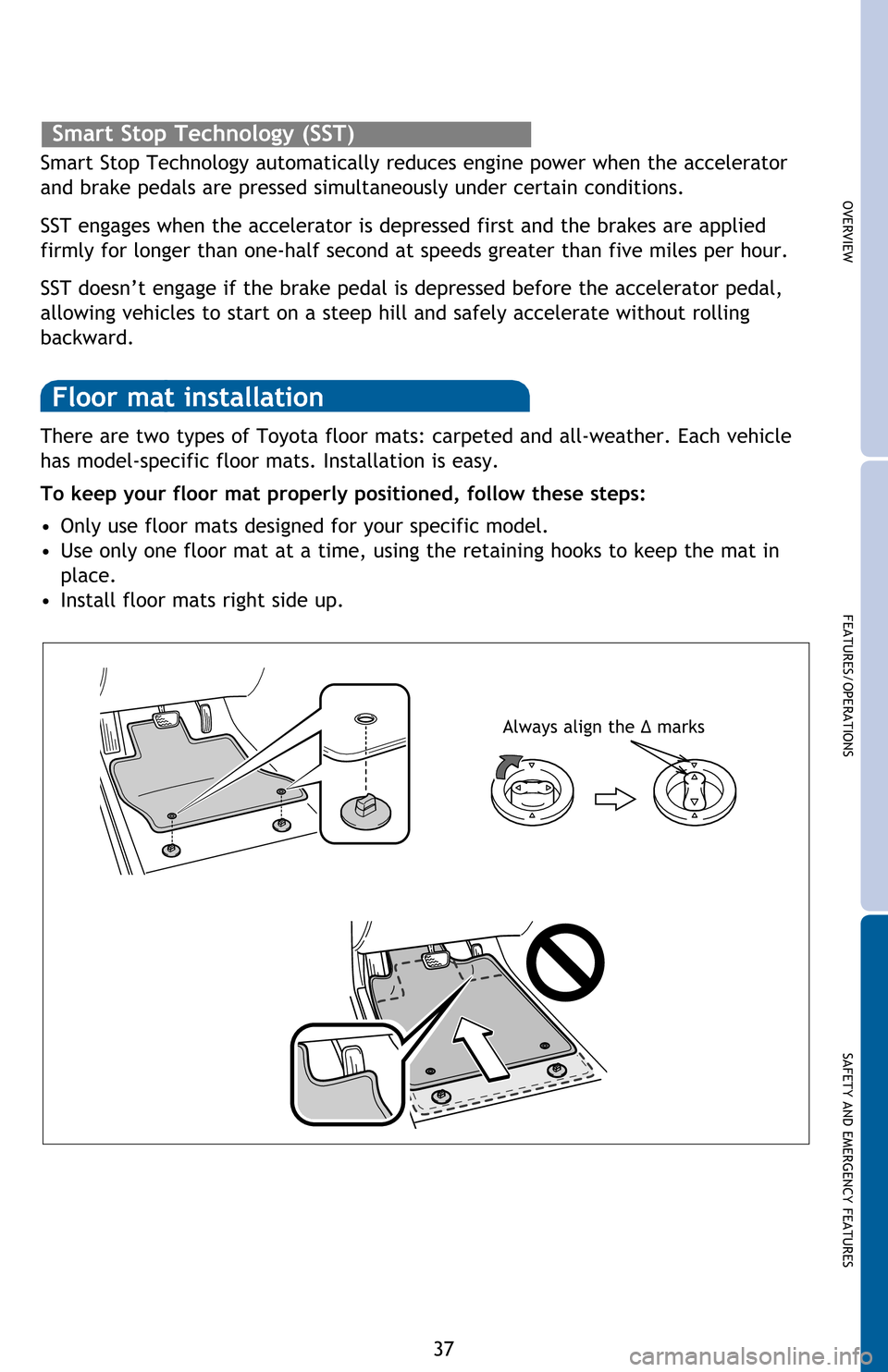
37
OVERVIEW
FEATURES/OPERATIONS
SAFETY AND EMERGENCY FEATURES
There are two types of Toyota floor mats: carpeted and all-weather. Each vehicle
has model-specific floor mats. Installation is easy.
To keep your floor mat properly positioned, follow these steps:
• Only use floor mats designed for your specific model.
• Use only one floor mat at a time, using the retaining hooks to keep the mat in
place.
• Install floor mats right side up.
Floor mat installation
Smart Stop Technology automatically reduces engine power when the accelerator
and brake pedals are pressed simultaneously under certain conditions.
SST engages when the accelerator is depressed first and the brakes are applied
firmly for longer than one-half second at speeds greater than five miles per hour.
SST doesn’t engage if the brake pedal is depressed before the accelerator pedal,
allowing vehicles to start on a steep hill and safely accelerate without rolling
backward.
Smart Stop Technology (SST)
Always align the �¨ marks